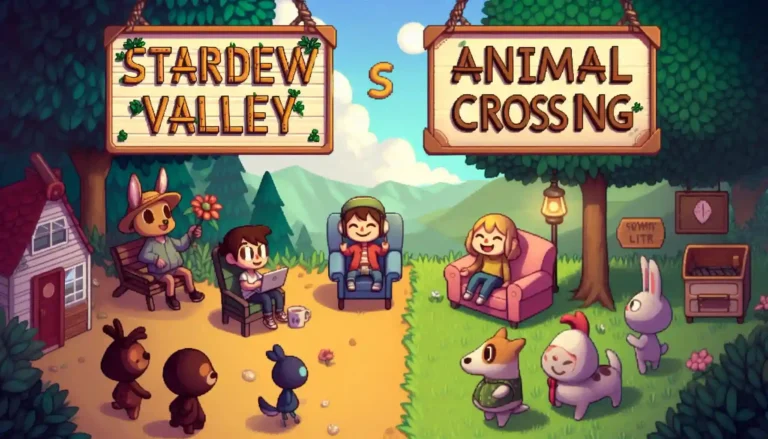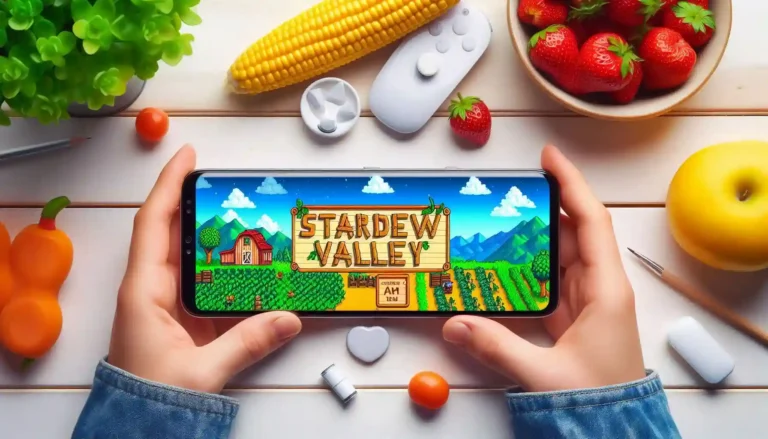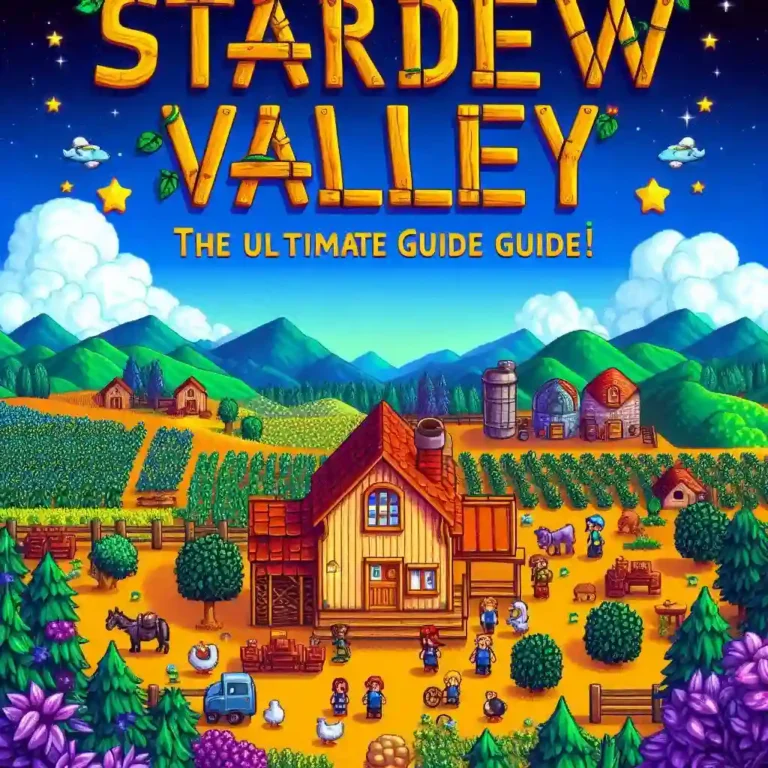StarDew Valley vs Harvest Moon: A Gamer’s Ultimate Guide
Growing up, I was thrilled when I first played Harvest Moon on my Super Nintendo. The gameplay was simple, yet it had a charm that kept me coming back. The idea of farming, building relationships, and helping a damaged town recover felt so refreshing. When Stardew Valley was released, it instantly reminded me of those nostalgic days, but with better mechanics and deeper RPG elements. Unlike the classic version, SV introduced combat, crafting, and seasonal events, making the gameplay more engaging. It felt like an improvement upon an old classic, adding a layer of depth that the series had been missing.
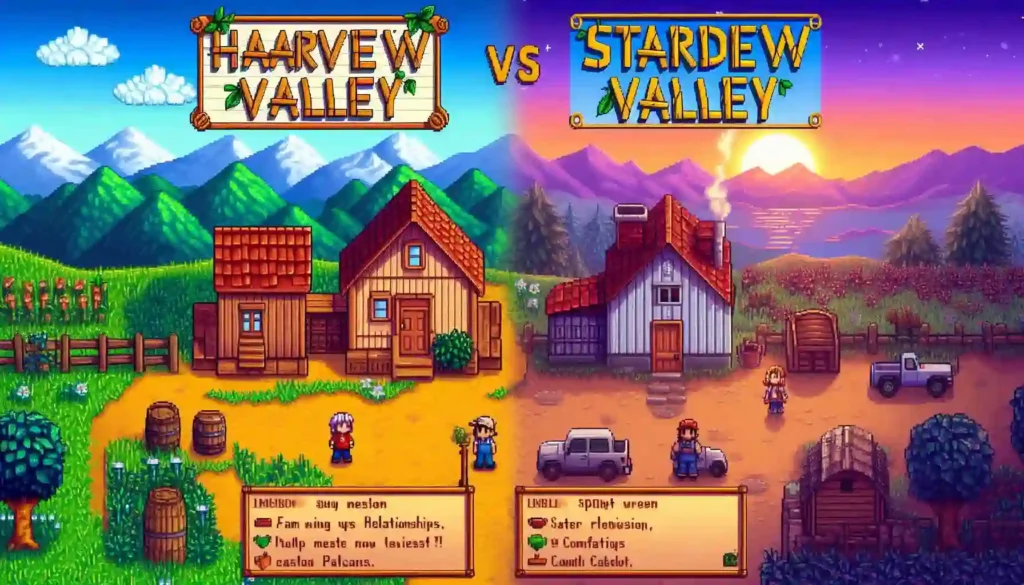
What makes these games stand out is their immense value in the gaming world. Both offer a satisfying simulation of farm life, but Stardew Valley’s modern features like same-sex marriage, customization, and a thriving community of mods make it feel like an Indie classic. On the other hand, Harvest Moon’s earlier titles had a simple, almost childish charm, which made them family-friendly and easy to pick up. While HM stuck to its plain yet stylish approach, SV introduced new in-game mechanics like mining, dungeon crawling, and trading, making it more competitive in today’s RPG-based market. The difference between these two isn’t just in the graphics or interfaces, but in how they’ve evolved—one embracing modern gaming savviness, while the other holds onto its roots.
Core Gameplay & Features
Working Mechanism Of Harvest Moon APK – What You Need To Know?
If you enjoy farming simulation games, then Harvest Moon might be the perfect fit. The game focuses on strategic decision-making while managing crops, livestock, and relationships within a small town. Players start with a devastated farm, often damaged by a storm, and must rebuild it using available resources and materials.
The gameplay involves planting seeds, watering crops, and yielding a profit by selling plants and food in the local market. The weather system is dynamic, meaning seasonal cycles affect how crops grow. Players must mitigate challenges by planning their farming strategies accordingly.
Beyond farming, livestock plays a crucial role. Players can buy and raise cows, sheep, and chickens to produce milk, wool, and eggs, which can be traded for money. Engaging with the community is essential, as building friendships, participating in festivals, and winning contests like dog racing bring additional rewards and unlock new locations on the map.
Distinct Features Of Harvest Moon APK
What makes Harvest Moon truly unique is its focus on rebuilding and restoring a small town. Players often need to reconstruct key buildings, such as lighthouses, barns, and homes, by collecting materials from the environment. The explore feature allows players to discover hidden areas, interact with characters, and take on different tasks to help the town thrive.
Another key aspect is experimentation in farming. Players can try mutation of crops, use crafting tools to enhance production, and engage in cooking with various recipes. Each season brings new festivals, where players can showcase their farming skills and earn rewards that help in customizing their farm and expanding their construction projects.
Working Mechanism Of Stardew Valley APK
While Stardew Valley follows the basic structure of Harvest Moon, it offers a more open-ended experience. Players inherit a piece of land and must progress by growing crops, raising animals, and earning money through various activities. Unlike Harvest Moon, where tasks are structured around rebuilding, Stardew Valley focuses on player freedom, allowing them to choose how they wish to expand their farm and interact with the community.
One of the extraordinary features of Stardew Valley APK is the presence of caves, where players can encounter deadly beasts and engage in combat mode to collect valuable resources. The game also introduces automation, making it easier for players to manage fields, tend to animals, and optimize crafting.
Unique Features Of The Stardew Valley APK
The unique aspect of Stardew Valley lies in its skill system. Unlike Harvest Moon, where progress is more traditional, this game allows players to specialize in different attributes such as farming, combat, crafting, and fishing. This adds a level of customization that keeps the gameplay engaging and fresh.
Additionally, players can focus on friendships and even marriage with villagers, each of whom has distinct personalities and issues that players can help resolve. Building relationships unlocks new items and purposes that further enhance the farming experience.
Stardew Valley vs Harvest Moon – Difference In The Features
| Feature | Harvest Moon | Stardew Valley |
| Farming Mechanics | Traditional farming with structured progression | More open-ended with automation |
| Livestock Management | Raising cows, sheep, and chickens for profit | Advanced customization and upgrades |
| Town Interaction | Focus on restoring a small town | Engaging community, deep relationships |
| Combat & Exploration | Minimal exploration, no combat | Caves, deadly beasts, combat mode |
| Progression System | Limited to tasks and rebuilding | Expanded skills, professions, and strategic choices |
Both games offer unique experiences, with Harvest Moon focusing on rebuilding, seasonal cycles, and festivals, while Stardew Valley provides a more modern, customizable, and dynamic approach to farming simulation. Players looking for a traditional experience may prefer Harvest Moon, while those who enjoy experimentation, automation, and deeper character relationships may lean towards Stardew Valley.
Gameplay Elements & Mechanics
Multiplayer Mode
One of the biggest differences between Stardew Valley and Harvest Moon is the multiplayer mode. In Stardew Valley, players can collaborate with their friends, forming a team of members to work together on various tasks such as farming, mining, and even attending festivals. This adds value to the gameplay focus, making the experience more social and engaging. Players can complete different challenges collectively, making the world feel alive.
On the other hand, Harvest Moon remains a single-player adventure, where progress is saved in a more solo-oriented manner. While its story-based activities allow for relationships with villagers, it lacks the online connectivity that many modern gamers enjoy.
Combat and Exploration
Exploring the caves in Stardew Valley is a thrilling experience. Players can fight monsters, collect treasures, and sell valuable items in the market. The risky nature of combat makes it an adventurous element, keeping the gameplay fresh. The mines are full of mysterious environments, where breaking rocks often leads to discovering rare and valuable resources.
In contrast, Harvest Moon has a more relaxing approach to exploration. While it has some adventurous elements, it does not focus on fighting or engaging in combat. Instead, the gameplay revolves around performing tasks like foraging, collecting gems, and caring for animals.
Fishing & Skill System
Both games offer fishing, but Stardew Valley introduces a more skill-based system. Catching fish involves a mini-game, where players need to time their button presses correctly. It’s challenging yet rewarding, as players can acquire new levels in skills and enhance their fishing abilities.
Meanwhile, Harvest Moon takes a simpler approach. Players can catch fish with a quick button press, making it easier but also less engaging for veteran players looking for a deeper challenge.
Extensive Crafting & Customization
The crafting system in Stardew Valley is one of the most extensive in indie gaming. Players can create a number of items, including artisan goods, tools, and even machinery to improve farming. The ability to upgrade and customize houses, farms, and buildings gives a personal touch to the gameplay.
In contrast, Harvest Moon offers limited customization. While decorative designs exist, they are often predefined and narrow in options. The older editions of the game focused more on a traditional farming experience rather than allowing players to extend their creativity.
Both games provide an engaging take on life simulation, but Stardew Valley stands out for its dynamic, seasonal events, expansions, and modding community, making it a game that
continuously evolves.

Story & Premise
Both Stardew Valley and Harvest Moon offer immersive storytelling that keeps players invested in their journey. However, their approach to storylines and world-building differs significantly.
In Harvest Moon, the central premise often revolves around inheriting a farm from a parent or uncle and working to restore it. The goal is usually to revive a damaged or abandoned land while also helping a struggling town. Some titles introduce magical elements, such as spirits or goddesses, but the core remains a simple yet nostalgic farming adventure.
On the other hand, Stardew Valley takes a more naturalistic approach, focusing on a player’s escape from the modern corporate world. The storyline is more player-driven, allowing for deeper immersion. SV also includes darker themes, such as aging, sacrifices, and community struggles. This adds a sense of realism that older HM titles lacked.
A major difference is that SV blew Harvest Moon out of the water with its ability to let players shape their own storytelling. Instead of being bogged down by tedious chores or glitches, the player gets to decide their actions, influencing the world around them in a more meaningful way.
The Story of Harvest Moon’s Development
The Harvest Moon series has evolved steadily over decades, introducing both special and flawed mechanics. Originally released on the SNES, the franchise became a breakout hit, leading to various spin-offs, such as Rune Factory, which added RPG elements like combat and crafting.
However, after the split between the original developers and publishers, the series rebranded as Story of Seasons, while the Harvest Moon name continued under a new team. This led to newer games that felt childish and lacked the depth of previous titles. Many YouTubers and critics noted how the recent entries felt meh compared to the classics, leading many players to prefer SV as an alternative.
Seasons & Calendar System
Both games feature a seasonal cycle that influences crops, events, and animals.
In Harvest Moon, seasons last 30 days, and if players fail to harvest their crops in time, they will be dead. This rigid system can be frustrating, especially for newcomers who don’t plan ahead. SV, however, offers more alternatives, such as the Greenhouse, allowing players to grow plants year-round.
The calendar system plays a crucial role in both games. In SV, birthdays, festivals, and romantic events are marked, making it easier to build relationships. Meanwhile, some HM titles have counter-intuitive scheduling, requiring players to memorize event dates manually. Missing a deadline in Harvest Moon 64 or A Wonderful Life can lead to zero enjoyment, as players must pass time without much to do.
Social & Community Aspects
Community Center Restoration
One of the most nostalgic features of SV is the Community Center restoration, which contrasts with Harvest Moon’s town missions. While both games emphasize helping the community, SV offers a more rewarding experience. Players feel attached to the villagers because their actions have weight, leading to visible improvements in the town.
In Harvest Moon, tasks often feel more like errands, with little impact on the world. Some games, like A Wonderful Life, attempt to add realism by making villagers age, but the execution often feels lacking compared to SV’s polished world-building.
Side Activities & Mini-Games
Both series include side activities beyond farming, such as mining, fishing, and festivals. HM often includes quirky mini-games, like milking cows, brushing horses, and racing dogs. However, some mechanics feel tedious, such as using a rucksack with limited space or dealing with a trellis blocking movement.
Meanwhile, SV’s side activities feel more fluid and engaging. Mining, for example, includes combat elements that add depth to exploration. The crafting system also encourages upgrades, making daily tasks feel less like chores.
Family and Marriage Mechanics
Both games emphasize relationship-building, but they approach marriage candidates and family life differently.
In Harvest Moon, romance is a core part of the storyline, but it often lacks complexity. Players choose from a set of bachelors or bachelorettes, give gifts, and eventually get married. However, some games force players into marriage or punish them with bad endings if they remain single for too long.
SV takes a more modern approach. Players can date freely and even dump a spouse if they change their mind. The romantic interactions feel more adult, and relationships have more personality, making it easier to feel attached to the characters.
Family life is also more dynamic in SV. In some HM titles, having children feels like an afterthought, with little content beyond naming them. However, SV allows for more involvement, including adopting kids and even choosing to reset family life if desired.
While Harvest Moon is known for its cute, stylized, and anime-inspired art style, SV’s pixel design carries its own nostalgia, making it a matter of preference. However, when it comes to gameplay depth and relationship mechanics, SV has clearly set a new standard.
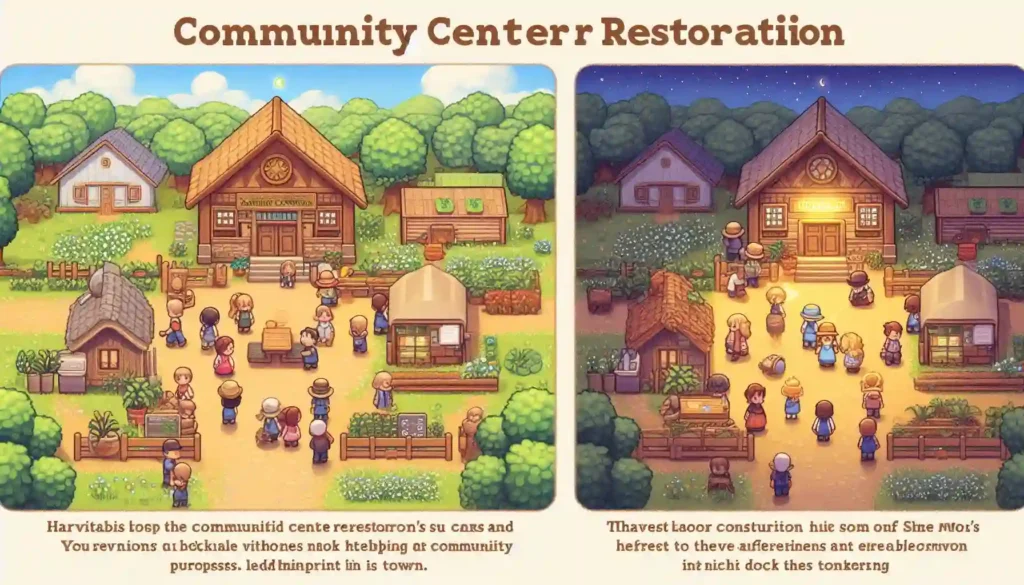
Visuals & Audio – A Tale of Two Styles
When comparing Stardew Valley and Harvest Moon, the way each game presents its graphics and sound is key to the experience. While one banks on nostalgia, the other has seen its art style evolve over the years. Both have unique ways of drawing players into their worlds, but which one does it better?
Stardew Valley’s Pixel-Art Charm: A Nostalgic and Expansive Experience
Inspired by classic titles like Final Fantasy and the SNES era of gaming, Stardew Valley leans heavily into its pixel-art design. This choice wasn’t just about aesthetics—it was a conscious decision to tap into the childhood memories of players who grew up with 1996-era games. The sprites are simple yet full of personality, making every interaction with townsfolk, livestock, and even monsters in the mines feel alive.
The game’s visual storytelling is equally expansive, with seasonal changes affecting everything from crops to weather patterns. The ability to customize your farm, home, and even furniture makes the game feel truly personalized. The art may be simple, but the sheer variety of items, features, and updates keeps the world fresh and engaging, adding layers of replayability.
Harvest Moon’s Evolving Art Style: From Classic to Modernized Charm
Unlike Stardew Valley, which sticks to its pixel-art roots, the Harvest Moon franchise has seen its graphics grow and evolve over time. From its 1996 launch on the SNES to more modernized titles with cuter, chibi-styled characters and even 3D environments, each game reflects the era it was made in.
The older entries had a peaceful undertone, much like the early Maxis simulation games such as SimCity and Civilization. The pace was slower, drawing in both casual and hardcore players who wanted to relax while still putting in the hard work to build a thriving farm. As newer entries introduced flashier visuals and a more user-friendly interface, the gameplay became more accessible to a wider demographic.
However, some long-time fans argue that the transition to 3D made the games feel less compact and cozy compared to their handhelds and portable counterparts. The shift also led to more comprehensive yet sometimes clunky mechanics, making some previous features feel lost in the transition.
Soundtrack & Audio Design: Setting the Atmosphere
Both games understand the importance of music in shaping the player’s experience. Harvest Moon has always had a wonderful, soothing soundtrack, often featuring soft anime pop tones that enhance its seasonal and festive atmosphere. Whether you’re tending to your ranching, fishing by the pond, or attending a festival, the music creates a sense of connection to the game’s world.
On the other hand, Stardew Valley offers a more robust and dynamic musical experience. The soundtrack adapts to different locations—exploring the mines brings eerie, almost haunting melodies, while winter has a somber, reflective theme. The subtle changes in weather and time of day affect how the audio is layered, making for a truly immersive playthrough.
Which One Feels More Immersive?
This comes down to personal preference. If you grew up playing Harvest Moon, its classic tunes and evolving visuals may feel more familiar. However, for those who enjoy expansive, customizable worlds with deep replayability, Stardew Valley’s nostalgic design and soundtrack may be the more appealing choice.
Progression & Customization
One of the most positive aspects of Stardew Valley is the freedom it offers in progression and customization. You can improve your skills, expand your farm, and even shape your own storylines through various choices. Players can explore unique, colorful areas, build relationships, and take part in farming activities at their own pace.
On the other hand, Harvest Moon follows a more structured set of rules. While it still allows engagement through farming and community interactions, it doesn’t offer as many options for personalizing your farm. The 3D graphics in newer versions give it a fresh look, but Stardew Valley’s pixel art style creates a more charming and nostalgic atmosphere.
Modding Support
If you love additional features and changing how a game plays, MOD support is an important factor. Stardew Valley has an extensive modding scene where the community continuously adds new updates, mechanics, and even whole new stories to explore. This extends the replayability and allows players to customize the experience in ways that are not possible in the base game.
Unfortunately, Harvest Moon has limited support for MOD content. Since the developers control its releases, there isn’t much room for players to tweak the game beyond what is officially provided. This makes it less appealing for those who enjoy experimenting with new features and changes.
Platform Availability
If you’re thinking about playing on different platforms, you should consider where these games are available. Stardew Valley is accessible on PC, console, and mobile, making it a great choice for a wider audience. It also supports both single-player and multiplayer mode, adding to its flexibility.
In contrast, Harvest Moon is mainly focused on console releases. While there are some versions available on mobile, its reach is not as extensive as Stardew Valley. The lack of official multiplayer mode in many versions also makes it feel more limited compared to its competitor.
Both games have their own strengths, but when it comes to freedom, modding, and platform accessibility, Stardew Valley clearly has more to offer.
Themes & Legacy
Stardew Valley: A Flexible Sandbox Experience
When Stardew Valley was released, it redefined the farming simulation genre by offering a tactically-immersive experience. Unlike the structured nature of Harvest Moon, players in Stardew Valley have the freedom to decide how they want to restore their farm. Whether it’s planting crops, raising livestock, or venturing into monster-infested caves, the game provides an accessible yet deep experience for a wide audience. The ability to manage relationships with villagers and even choose a kind of life beyond just farming adds an overall depth that resonates with both hardcore and casual gamers.
Harvest Moon: A Structured, Laid-Back Farming Adventure
In contrast, Harvest Moon follows a more traditional formula, making it a chill encounter that appeals to younger gamers and those looking for a relaxation-focused experience. The trope of a young person inheriting a farm from their grandfather and working to restore it has been a key theme in the franchise for decades. While the game offers a mix of planting, clearing land, raising livestock, and foraging, it keeps things simple, ensuring that tasks don’t overwhelm the player. The gameplay is compact and encourages short sessions, making it perfect for players who want a slower-paced, comforting routine.
The Legacy of Both Games
How Harvest Moon Paved the Way for Farm Simulators
Long before Stardew Valley became a global success, Harvest Moon had already popularized the farming simulation genre. It introduced many of the mechanics that later games, including Stardew Valley, would refine. The franchise set the standard for engaging gameplay, warm villages, and meaningful relationships with villagers. It also helped make farm sims mainstream, appealing to a wider audience by keeping mechanics accessible and engaging.
Stardew Valley’s Innovations and Modernizations
Despite following the formula of its predecessor, Stardew Valley modernized the genre in a way that made it feel fresh. With its expansive features, the game accommodates different playstyles, from casual fans who enjoy farming and decorating to hardcore gamers who focus on optimizing profits and monster slaying in the mines. The integration of RPGs elements, such as combat, hunting, and exploration, added another layer of variety. The game also introduced online community features, letting players play together, which wasn’t common in early titles of the genre.
Innovation & Longevity
What Makes Stardew Valley More Adaptable?
One of the key reasons Stardew Valley remains relevant is its modern UI and ability to integrate new content seamlessly. Developer ConcernedApe continuously improves the game, ensuring that it evolves with the gaming community’s expectations. The game’s graphics strike a perfect balance between gorgeous sprite art and modern, realistic visuals, making it appealing to both nostalgic players and new audiences.
Additionally, Stardew Valley has successfully transitioned to multiple platforms, including the Switch port, making it more accessible than ever. The variety of in-game activities, from selling crops to managing an inheritance, ensures long-term engagement. Players are in charge of their own story, whether they want to focus on farming, becoming a legendary monster slayer, or forming deep relationships with villagers.
Why Harvest Moon Remains a Classic
Even though Stardew Valley has taken the genre to new heights, Harvest Moon continues to be a beloved franchise due to its simple, chill nature. The music, sound design, and visuals are banked on nostalgia, offering a perfect escape for those who prefer a more laid-back experience. The physical release of its older titles still holds sentimental value for long-time fans who appreciate the comfort of a familiar game.
While Stardew Valley may have expanded on the formula, Harvest Moon remains a point of reference for many younger gamers looking for a charming, classic introduction to the genre.
Harvest Moon Vs Stardew Valley – Who Is The Winner?
Conclusion
Both Harvest Moon and Stardew Valley have been admired by different audiences over time. The best game depends on what kind of features you prefer. If you are looking for a classic structured farming experience with charming 3D graphics, Harvest Moon is a great choice. But if you want a more evolved, trending, and engaging gameplay with deep RPG elements, Stardew Valley is the ultimate winner.
Regardless of which game you pick, both offer hours of total fun and satisfying activities to keep you hooked.
FAQs & Additional Information
Reader Interactions
Share Your Farming Adventures
We know every farmer’s journey is unique! Did you meet your wife or husband at the village tavern? Were you a newcomer who relished the manual labor, or did you struggle with budget management? Maybe you had a pre-teen obsession with collecting expensive gifts for your crush, just like in real life? Share your experiences in the comments!
Poll: Stardew Valley vs. Harvest Moon
Which farming simulator do you prefer? Does Stardew Valley do a better job of recreating the classic Super Nintendo Harvest Moon experience, or do you still love the chunky pixels and modest charm of the original? Vote below and let’s settle this age-old debate!
Join the Community Discussion
If you’ve spent hours strategizing the perfect crop rotation, wooing video game characters, or trying to find the best method of affection for your virtual partner, we want to hear from you. Have any dating tips? Did you ever make the mistake of giving the wrong birthday gift? Let’s discuss how Stardew Valley and Harvest Moon shaped our views on relationships, personal growth, and money management.
Stay Connected with Us!
The fanbase for both games is vast and dedicated, filled with players who love the depth of customization, the relaxing experiences, and the joy of tending to crops. Whether you’re someone who enjoys the casual pace of Harvest Moon or the intricate mechanics of Stardew Valley, there’s always something fun to discuss.
If you love farming in a fantasy world, battling with swords, or befriending NPCs, you’ll find plenty of discussions in online communities. From deep comparisons of mechanics to talks about the evolution of the genre, players are always sharing their feedback and engagement.
Footer & Miscellaneous
Disclaimer
This article is written to provide detailed insights into these two beloved titles. While every effort has been made to ensure accuracy, please note that game development, updates, and localization may change over time. The information here is based on official translations, versions, and player experiences.
Pages
Looking for more detailed guides on farming, mining, or fishing in Stardew Valley? Want to dive into the history of Harvest Moon, its developers, and its publisher, Natsume? Check out our other pages where we explore everything from the past of these franchises to their modern-day expansions.
Final Thoughts on Both Games
Both games offer a unique experience. Harvest Moon, now under the Marvelous banner, holds a nostalgic appeal for those who grew up with its traditional gameplay. On the other hand, Eric Barone, also known as ConcernedApe, crafted Stardew Valley as an indie surprise hit, bringing an excellent level of depth, optimization, and updates.
If you love progressing through the seasons, dating, getting married, and experiencing an iterative take on the farm sim genre, Stardew Valley is perfect for you. However, if you prefer a more established and commercially recognized series, the Harvest Moon and Story of Seasons titles might be a better fit.
Let’s Keep the Discussion Going!
Which game do you think is the best? Do you enjoy the freedom and creativity of Stardew Valley, or do you prefer the traditional structure of Harvest Moon? Leave a comment and share your experiences! Also, follow us on social media to stay updated on the latest news, ports, and enhanced versions of these games.

